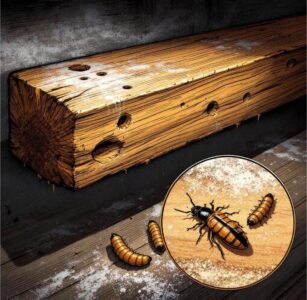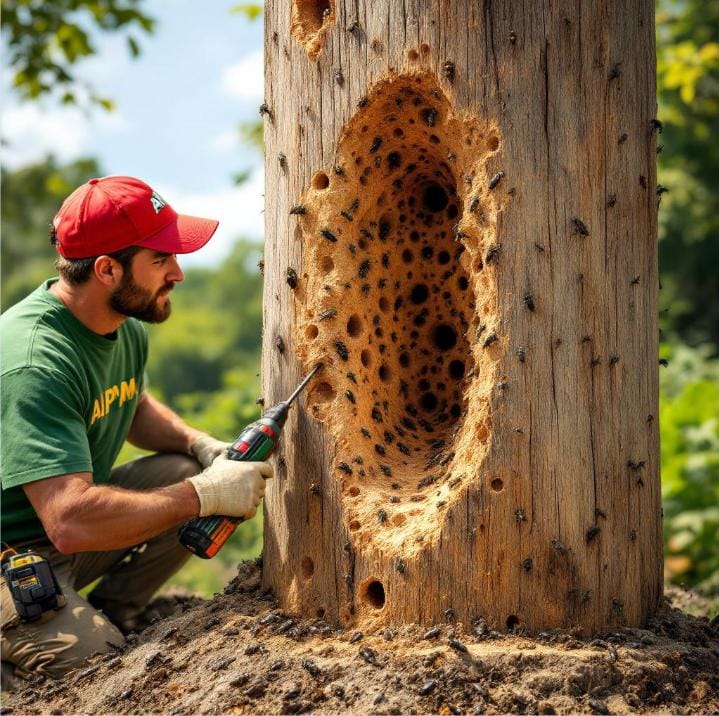Pest Library
What is a Wood Borer?
Wood borers are insects that infest and damage wooden structures by boring holes and tunneling through the wood to lay their eggs. The most common types include powderpost beetles, longhorn beetles, and woodworms. These pests typically target wooden furniture, beams, flooring, and doors—especially in moist or untreated wood. The larvae do the most damage as they feed on the wood from the inside, often going unnoticed until tiny exit holes, fine sawdust (frass), or weakened structures appear. If left untreated, wood borer infestations can compromise the integrity of valuable wooden assets.

Order Blattodea
IDENTIFY
❓ Why Do Wood Borers Come?
Wood borers are attracted to wood that is damp, untreated, or aged, as it provides the perfect environment for laying eggs and feeding. Moisture is a key factor—leaking pipes, poor ventilation, or high humidity can weaken wood and invite infestation. Softwoods, untreated timber, and old wooden furniture are especially vulnerable. Once the adult beetle lays eggs inside cracks or pores of the wood, the larvae hatch and tunnel through the wood for years, causing internal damage before emerging.
Locate them
🔍 How to Identify a Wood Borer Infestation?
Identifying a wood borer infestation early is crucial to preventing serious damage. Common signs include tiny, round exit holes on wooden surfaces, often 1–2 mm in diameter. You may also notice fine, powdery dust (frass) falling from these holes, which is the waste left by larvae as they bore through the wood. Other indicators include crumbling edges, damaged furniture, blistered wood, or hollow sounds when you tap the wood. In severe cases, you may even see adult beetles emerging from the holes.

Residential Areas
Bathrooms: Behind toilets, under sinks
Basements/Garages: In cracks, under clutter

Public And Commercial Spaces
Warehouses: Among boxes, under pallets
Grocery Stores: In stockrooms, under shelves

Outdoor Environments
Gardens: Under mulch, around plant bases
Sewers/Drains: Inside pipes, near manholes

Pest Treatment
🛡️ How we Control Wood Borers?
Controlling wood borers requires a combination of early detection, professional treatment, and preventive maintenance. Begin by inspecting wooden items regularly for small holes, frass (powdery dust), or weakened surfaces. Remove and isolate infested items to prevent further spread. For active infestations, professional pest control is essential—AIPM Pest Management uses industry-grade, odorless chemical treatments that penetrate deep into the wood to kill larvae and prevent reinfestation. In some cases, fumigation or wood sealing may be recommended for complete protection. We also advise treating untreated wood and keeping indoor areas dry and well-ventilated, as moisture attracts borers. Our expert team ensures your wooden structures stay safe, strong, and pest-free.

FAQ
Frequently asked questions.
Signs include:
Small round exit holes on wooden surfaces
Fine wood dust (frass) under furniture or wooden fixtures
Ticking or tapping sounds inside wood
Weak or brittle wooden items
Wood borers eat through internal wood layers, making the structure weak from inside. Over time, they can cause serious damage to furniture, wooden flooring, and even structural timber if not treated early.
We use a combination of methods:
Injection of wood preservative chemicals into the exit holes
Surface spray treatment on infested and surrounding wood
In severe cases, fumigation or removal of the affected wood may be recommended
Yes. All treatments are carried out using safe and approved chemicals, and we follow all safety protocols to protect your family and pets. Rooms can usually be reoccupied shortly after treatment.
Yes. We offer treatment warranties and Annual Maintenance Contracts (AMC) for long-term protection, especially for commercial properties and institutions with large wooden assets.
Eliminate pests and prevent future problems.
- +91 9607171409
